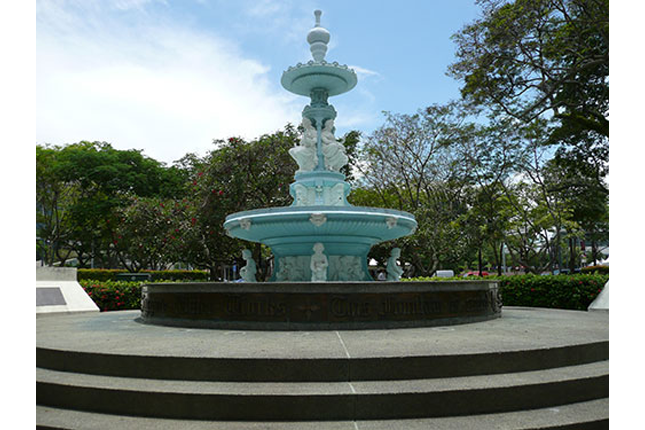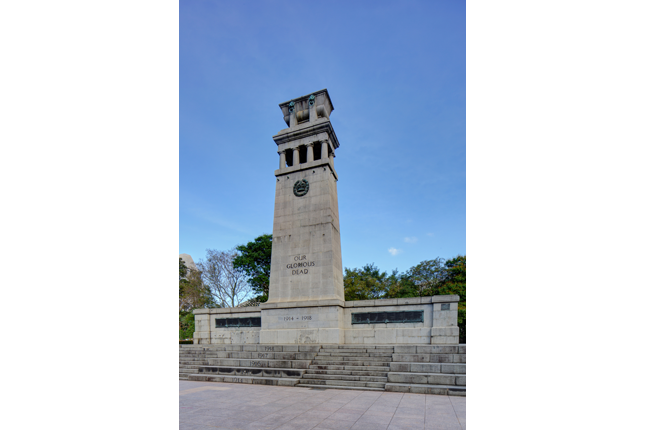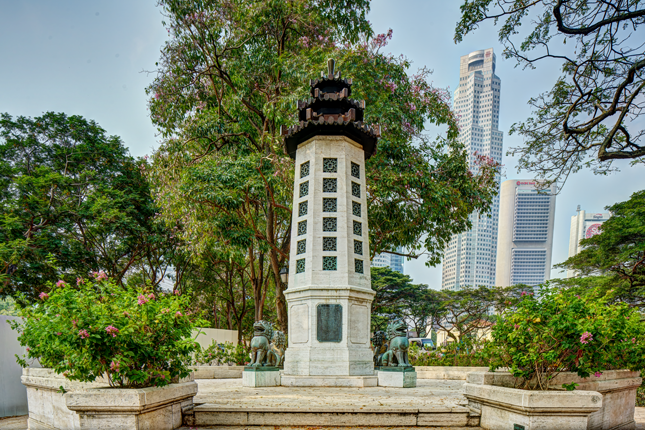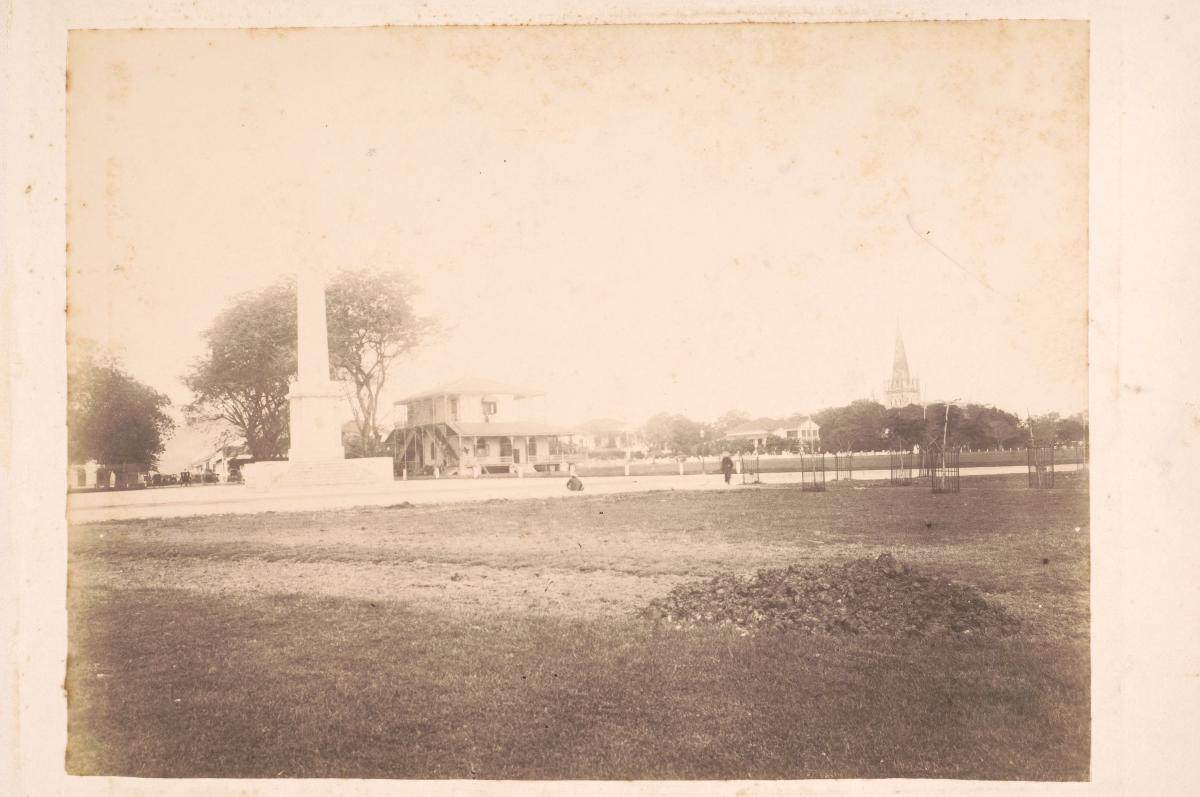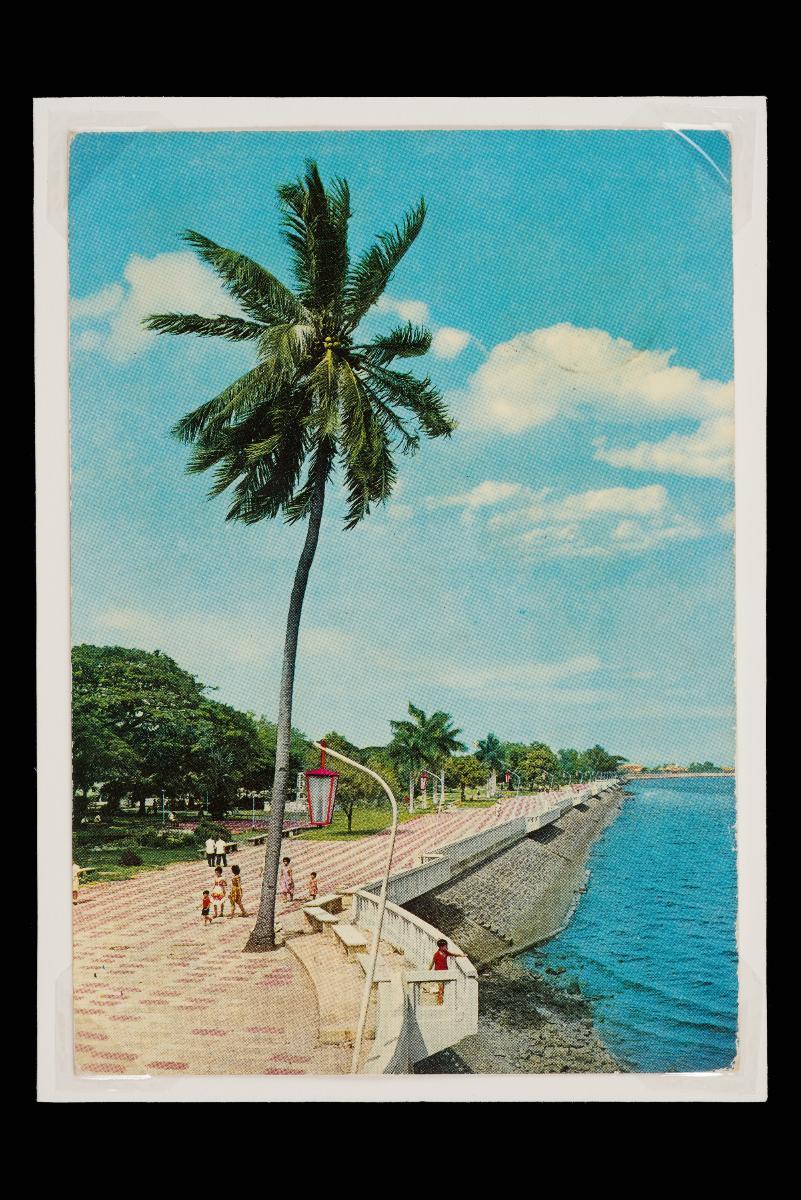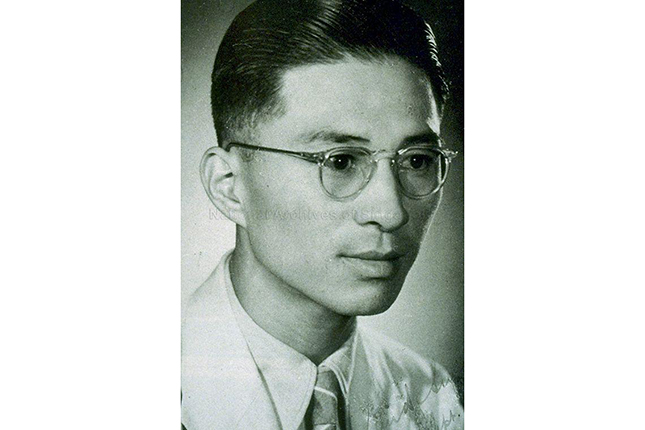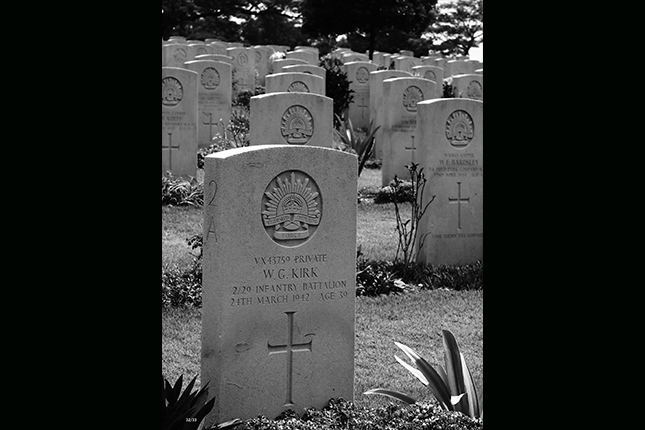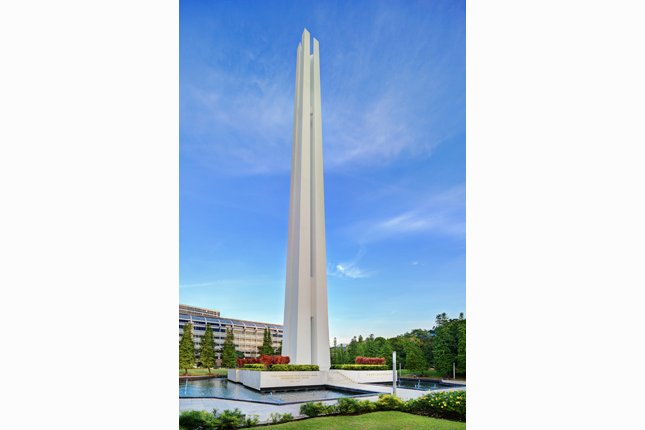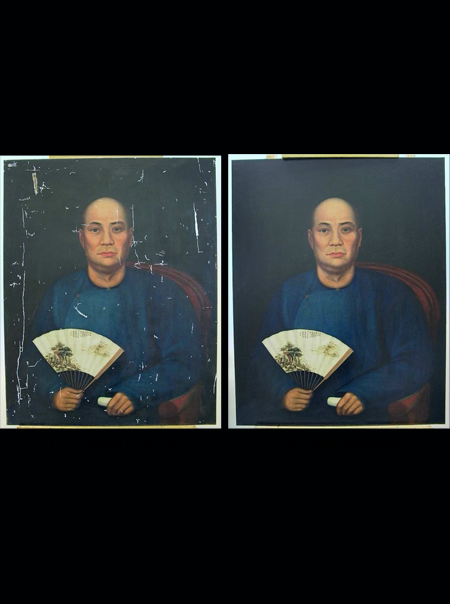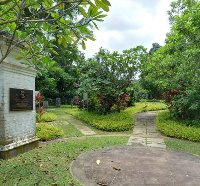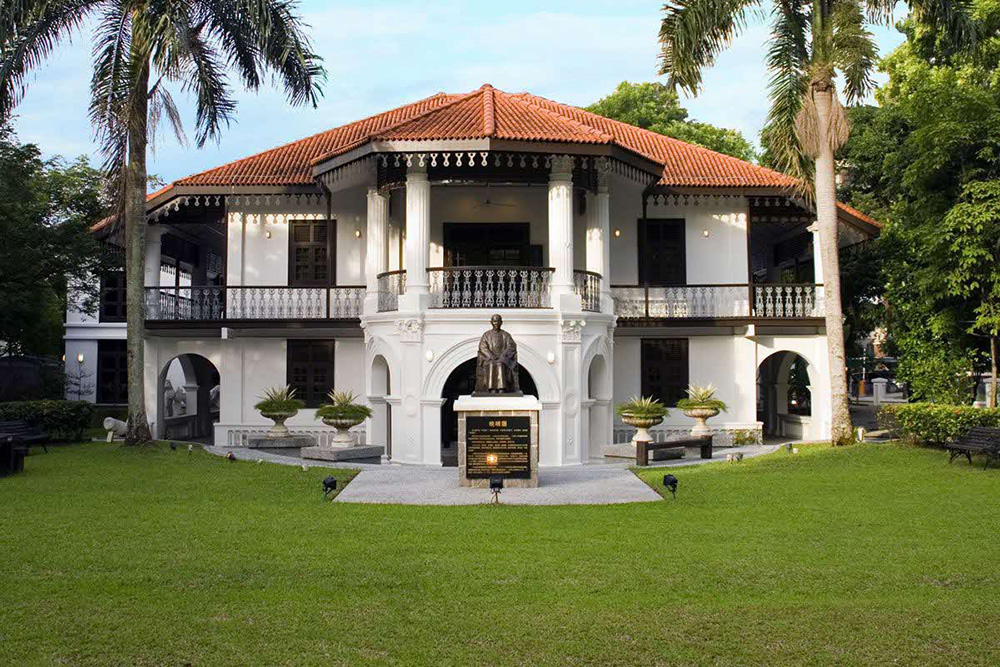Prior to the first land reclamation in 1843, the original shoreline of Singapore ran across the present Padang. Esplanade Park, which was created during the 1922 reclamation project, sits entirely on new land today, and has since been transformed into a commemorative park. A stretch of promenade along the seafront was named Queen Elizabeth Walk in 1953, in celebration of the monarch’s coronation and ascent to the English throne. It was officially opened by Lady Yuen-Peng McNeice on 30 October that same year.
At Esplanade Park are Tan Kim Seng Fountain, the Cenotaph, and Lim Bo Seng Memorial. These three memorials were gazetted collectively as a National Monument.
- Tan Kim Seng Fountain
- Cenotaph
- Lim Bo Seng Memorial
Construction: 1882
Designer: Andrew Handyside & Company of Britannia Ironworks in Derby, England

The ornate Tan Kim Seng Fountain was commissioned by the Municipal Council to commemorate the philanthropist’s contributions to Singapore. It was first unveiled on 19 May 1882 at Fullerton Square by Sir Thomas Scott, President of the Municipality.
Tan Kim Seng
Tan Kim Seng (陈金声) was a leader of the local Chinese community and an avid supporter of the Chinese Pauper Hospital (Tan Tock Seng Hospital today). To increase the literacy rate among the Chinese, he also founded two educational institutions, Chongwen Ge (崇文阁) on Telok Ayer Street and Chui Eng Si E (萃英书院) on the nearby Amoy Street. He is perhaps best remembered for his generous gift of 13,000 Spanish dollars to public waterworks construction to supply freshwater to the Singapore Town in 1857.
Features
Made in cast iron, the exquisite fountain features four Muses – Greek goddesses of science, literature, and the arts – in its lower bowl, each bearing an object of her patronage. Calliope, the Muse of Epic Poetry, carries a writing tablet; Clio, the Muse of History, carries a scroll; Erato, the Muse of Lyric Poetry, carries a lyre; and Melpomene, the Muse of Tragedy, carries a wreath. Beneath the sculptures of the Muses are four faces of Poseidon, the God of the Sea according to Greek mythology, each spouting water.
The fountain was moved to its current location at Esplanade Park in 1929, when Fullerton Building was under construction.
More information on this monument can be found in Singapore Infopedia, National Library Board.
Construction: 1920 - 1922
Architect: Denis Santry of Swan & Maclaren

The Cenotaph is a war memorial that commemorates the military personnel who fought and sacrificed their lives in both World Wars.
Construction
It was originally erected to honour the 124 men from the Colony of Singapore who left for the war in Europe during the First World War (1914–1918) and never returned. Governor of the Straits Settlements Sir Laurence N. Guillemard laid the foundation stone on 15 November 1920. Premier of France Georges B. Clemenceau was also present at the ceremony. On 31 March 1922, the completed Cenotaph was unveiled by the visiting Prince of Wales, Edward VIII.
Features
The Cenotaph was designed by Denis Santry from the renowned architectural firm Swan & Maclaren. He was also the architect for Sultan Mosque and the Former Tanjong Pagar Railway Station. The memorial was modelled after the Cenotaph in Whitehall, London.
Constructed using local white granite, the structure is nearly 60 feet (18 metres) tall. There are five steps leading up to the memorial, each engraved with a year of the Great War. On the Cenotaph is the phrase ‘Our Glorious Dead’, which immediately calls to mind the sacrifice of the brave men. At the top of the memorial is a sarcophagus, featuring a bronze medallion of a crown – a symbol of the Crown Colony – surrounded by a laurel wreath which represents victory and peace.
The names of the 124 victims were inscribed on bronze plates mounted on the memorial. Among those who perished in the war in Europe were Reverend Father Alcide E. Laurent from the Society of the Foreign Missions of Paris (MEP), the young assistant priest at the Church of the Nativity of the Blessed Virgin Mary, and Reverend Father Charles B. Nain, who prepared the architectural plans of the same church, the Former Chapel of the Convent of the Holy Infant Jesus, and the curved wings of the Former Saint Joseph’s Institution.
Memorial for the Military Victims of the Second World War
After the Japanese Occupation (1942–1945), the reverse side of the Cenotaph was dedicated as a memorial for the military personnel who defended Singapore and perished during the Second World War. The words ‘They died that we might live’ were cast in bronze plates in Singapore’s four official languages – English, Chinese, Malay (in Jawi script), and Tamil – and set on the structure. Similarly, the years of the Second World War (which began in Europe in 1939) were carved into the steps.
More information on this monument can be found in Singapore Infopedia, National Library Board.
Construction: 1953 - 1954
Architect: Ng Keng Siang

Lim Bo Seng Memorial is the only commemorative structure in Singapore that honours the sacrifice of an individual during the Second World War. Lim Bo Seng (林谋盛) was born in Nan’an in Fujian Province. His father, Lim Loh (林路) – also known as Lim Chee Gee (林志义) or Lim Hong Leong (林云龙) – was a well-known contractor in Singapore at that time; among the construction projects he took on were Hong San See and Goodwood Park Hotel.
Lim Bo Seng
Lim Bo Seng had been active in anti-Japanese efforts since the outbreak of the Second Sino-Japanese War (1937–1945). He fled Singapore just before it fell to the Japanese, but he continued recruiting and building a guerrilla force against the Japanese invaders in Malaya. The resistance group became the famed Force 136.
When Lim was travelling through a checkpoint in Gopeng, Perak, he was unfortunately betrayed and was arrested by the Kempeitai (Japanese Military Police). Despite repeated torture, Lim refused to name his companions. He finally succumbed to his injuries and died in Batu Gajah Prison, in Perak, on 29 June 1944.
After the war, his remains were brought back to Singapore. He was posthumously promoted to the rank of Major General by the Nationalist Government of the Republic of China. A dignified funeral was held outside the Municipal Building (the Former City Hall today), and his gravestone was erected at MacRitchie Reservoir. It was also decided that a memorial be erected at the Esplanade in honour of the war hero.
The foundation stone for the memorial was laid by Commissioner-General Malcolm MacDonald on 23 November 1953 in the presence of Lim’s family members. On 29 June the following year, the tenth anniversary of Lim’s death, General Sir Charles Loewen, then Commander-in-Chief of the Far East Land Forces, unveiled the memorial.
Features
Lim Bo Seng Memorial was designed in the Chinese National style by local architect Ng Keng Siang. This style blends traditional Chinese elements with modern architecture, and is often characterised by a distinctively Chinese-style roof atop a concrete structure. The memorial comprises a 3.5-metre octagonal pagoda resting on a platform. Four bronze guardian lions sit at the base of the pagoda. Four commemorative plaques narrating the life and sacrifice of Lim in English, Chinese, Malay (in Jawi script), and Tamil can be found embedded on the façade of the memorial.
Our National Monuments
Our National Monuments are an integral part of Singapore’s built heritage, which the National Heritage Board (NHB) preserves and promotes for posterity. They are monuments and sites that are accorded the highest level of protection in Singapore.




